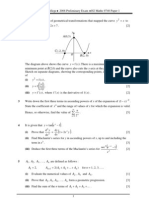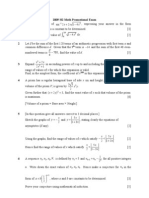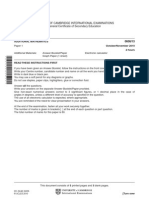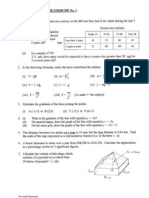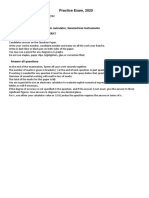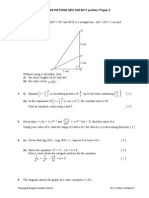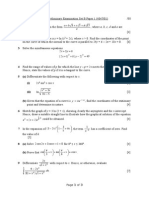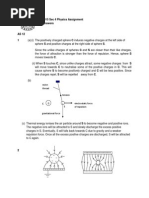(Turn Over
(Turn Over
Uploaded by
miaowCopyright:
Available Formats
(Turn Over
(Turn Over
Uploaded by
miaowOriginal Description:
Original Title
Copyright
Available Formats
Share this document
Did you find this document useful?
Is this content inappropriate?
Copyright:
Available Formats
(Turn Over
(Turn Over
Uploaded by
miaowCopyright:
Available Formats
1.
2.
3.
4.
Given that log 3 p = 0.6 and log 3 q = 1.7 , evaluate the following without using a
calculator:
log 3 p 2 q ,
(i)
q
log 3 3 .
(ii)
p
Given the function y =
[2]
[2]
x
, find the set of values of x for which y is an increasing
e2 x
function of x.
[4]
Solve the following equations:
(i)
log9 [log4 (x 7)] = 0.5
(ii)
log2 y = 25 logy 2.
[2]
[3]
Find the equation of the normal to the curve y =
x2
ln x 3 at the point where
2
it is parallel to the line 2y = x 5.
[5]
5.
Solve the following equations, correct your answers to 3 significant figures when
necessary:
[3]
(i)
72x1 = 5x+3,
[4]
(ii)
3ex + 2ex = 5,
6.
Water is poured into an inverted conical container which
has height 12 cm and radius 8 cm. After some time, the
depth of water in the container is h cm and the area of
water not in contact with the container is A cm2. Given
that the rate of change of A is 0.6 cm2s-1 when r = 4.8 cm,
find
dr
in terms of ,
[3]
(i)
dt
the rate at which V is increasing at that instant. [3]
(ii)
1
{Volume of cone = r 2 h }
3
Pg 3
8 cm
r
12 cm
h
[ Turn over
7.
The figure below shows a quadrilateral ABCD in which BAD and BCD are right
angles, AB = 3 cm, AD = 9 cm and ADC is a variable angle , where 0 < < 90 .
X and Y are on CD and AX respectively such that AXD and AYB are right angles.
A
3 cm
B
Y
9 cm
(i)
(ii)
8.
Show that the area, A cm2, of the quadrilateral ABCD is given by
A = 18 sin 2 + 27 sin 2
[4]
Find the maximum value of the area.
[4]
Differentiate with respect to x,
(i)
(ii)
(iii)
(iv)
9.
3 x + e 2 x ln x ,
1+ x2
,
2 tan 3 x
ln [(1 4x)(x2 + 3)],
e 2 x 1
.
sec 3x
[3]
[3]
[2]
[3]
A particle moves in a straight line such that its displacement s metres from a fixed
point O on the line at time t seconds is given by the formula s = t3 + 4t2 + 3t 5.
Find
(i)
the distance between point O and the starting point,
(ii)
the time interval where the particle is travelling in the positive direction,
(iii) the distance travelled by the particle in the first 4 seconds,
(iv)
the maximum velocity which the particle attains.
[1]
[3]
[3]
[3]
Bonus Question
10.
If a > b > 1 and
1
1
1
1
+
= 629 , find the value of
log a b log b a
log ab b log ab a
~ ~ ~ The End ~ ~ ~
Pg 4
[3]
You might also like
- Question Bank 0606Document189 pagesQuestion Bank 0606WeteachNo ratings yet
- Logs S Rds IndicesDocument19 pagesLogs S Rds IndicesRayYongNo ratings yet
- 2012 MJC MBT QN Paper For JC2 MBT RevisionDocument3 pages2012 MJC MBT QN Paper For JC2 MBT RevisionAng Wei NengNo ratings yet
- Answer All Questions: Ab A B B ADocument3 pagesAnswer All Questions: Ab A B B AAndy ChengNo ratings yet
- VJC H2 Math P1Document4 pagesVJC H2 Math P1jimmytanlimlongNo ratings yet
- 4037 w10 QP 13Document8 pages4037 w10 QP 13mstudy123456No ratings yet
- 2008 YJC Paper 1Document4 pages2008 YJC Paper 1karpeoNo ratings yet
- 2010 DHS Paper 1Document5 pages2010 DHS Paper 1Pooja KapurNo ratings yet
- OCR C1 June 05 - Jun 10 PDFDocument25 pagesOCR C1 June 05 - Jun 10 PDFmensah142No ratings yet
- Calculus PracticeDocument19 pagesCalculus PracticeJohhnnyBoyo101No ratings yet
- Anna University Maths Question BankDocument56 pagesAnna University Maths Question BankabhynayaNo ratings yet
- Pure Maths IADocument3 pagesPure Maths IAAntonio WallaceNo ratings yet
- James Ruse 2008 3U TrialDocument6 pagesJames Ruse 2008 3U TrialEmilyWongNo ratings yet
- Practice Paper BDocument3 pagesPractice Paper BkeyitsmeNo ratings yet
- Differentiation 3Document11 pagesDifferentiation 3Sc KhooNo ratings yet
- Maths 2009 Promo QuestionsDocument5 pagesMaths 2009 Promo QuestionsGuzzy OrcaNo ratings yet
- SMSO 2004 Paper 1Document4 pagesSMSO 2004 Paper 1api-25887606No ratings yet
- 0606 w10 QP 13Document8 pages0606 w10 QP 13Kimberley Fnick ChanNo ratings yet
- AJC JC 2 H2 Maths 2011 Mid Year Exam Question Paper 1Document5 pagesAJC JC 2 H2 Maths 2011 Mid Year Exam Question Paper 1jimmytanlimlongNo ratings yet
- 2022 Exponentials and Logarithm Test (10acc) (DBCN)Document6 pages2022 Exponentials and Logarithm Test (10acc) (DBCN)shawn.chienNo ratings yet
- B y Ax C X Ab andDocument4 pagesB y Ax C X Ab andjimmytanlimlongNo ratings yet
- Holy Innocents' High School: Mid-Year Examination 2016 Secondary 3 Express Additional MathematicsDocument8 pagesHoly Innocents' High School: Mid-Year Examination 2016 Secondary 3 Express Additional MathematicsZhao Yu QingNo ratings yet
- S4 Credit HomeworkDocument13 pagesS4 Credit HomeworkknoxmathsNo ratings yet
- Additional Mathematics 2009 November Paper 1Document8 pagesAdditional Mathematics 2009 November Paper 1lornarifaNo ratings yet
- Chapter 9 - Differentiation 1Document3 pagesChapter 9 - Differentiation 1Hao WeiNo ratings yet
- VJC 2015 H2 J1 Math Promos Questions Singapore JC VictoriaDocument5 pagesVJC 2015 H2 J1 Math Promos Questions Singapore JC VictoriaAlxNo ratings yet
- Stationary PointDocument4 pagesStationary PointLOVE WITH MATHEMATICSNo ratings yet
- 4037 Additional Mathematics Question Paper 01 Visually ImpairedDocument28 pages4037 Additional Mathematics Question Paper 01 Visually Impaireddanielkasanga57No ratings yet
- 2 Unit Year 11 Yearly 2010Document10 pages2 Unit Year 11 Yearly 2010carinaa_truongNo ratings yet
- Additional Mathematics 2010 November Paper 13Document8 pagesAdditional Mathematics 2010 November Paper 13Sharifa McLeodNo ratings yet
- Eton Education Centre A Compilation of Pure Maths Questions From JCS' Mye Papers 2010 Suitable For Practice in Preparation of Prelim ExamsDocument4 pagesEton Education Centre A Compilation of Pure Maths Questions From JCS' Mye Papers 2010 Suitable For Practice in Preparation of Prelim Examsgaobo9109No ratings yet
- Additional Mathematics 2010 June Paper 11Document8 pagesAdditional Mathematics 2010 June Paper 11Sharifa McLeodNo ratings yet
- James Ruse 1990 4U TrialDocument3 pagesJames Ruse 1990 4U TrialDean PhamNo ratings yet
- Practice Paper AM 2Document11 pagesPractice Paper AM 2Naveed AhmedNo ratings yet
- 4037 w08 QP 2Document8 pages4037 w08 QP 2mstudy123456No ratings yet
- H2 Maths Weekend Assignment For JC2: 2009 JJC Prelim Exam P 1Document4 pagesH2 Maths Weekend Assignment For JC2: 2009 JJC Prelim Exam P 1ManFang NeoNo ratings yet
- University of Cambridge International Examinations General Certificate of Education Ordinary LevelDocument8 pagesUniversity of Cambridge International Examinations General Certificate of Education Ordinary Levelmstudy123456No ratings yet
- SE - 2010 Question Paper SetDocument687 pagesSE - 2010 Question Paper SetBhargava S Padmashali100% (1)
- Ajc H2 Math P1Document6 pagesAjc H2 Math P1jimmytanlimlongNo ratings yet
- Mathematics ExamDocument10 pagesMathematics ExamJames JarrousNo ratings yet
- CBSE Board Class IX MathematicsDocument19 pagesCBSE Board Class IX MathematicsMintu KhanNo ratings yet
- Additional Mathematics 2008 November Paper 2Document8 pagesAdditional Mathematics 2008 November Paper 2lornarifaNo ratings yet
- Mathematics: Year 12 Trial HSC ExaminationDocument17 pagesMathematics: Year 12 Trial HSC ExaminationJessie LeungNo ratings yet
- Hci JC 2Document7 pagesHci JC 2Hang VuongNo ratings yet
- YJC_2008 YJC H1 PrelimDocument4 pagesYJC_2008 YJC H1 Prelimjackkale55No ratings yet
- Tanjong - Katong - 2011 A Maths Prelim P2Document5 pagesTanjong - Katong - 2011 A Maths Prelim P2Hui XiuNo ratings yet
- PM FM 5Document2 pagesPM FM 5biloma6323No ratings yet
- 2010 - Term 1 Grade 11 Maths ExamDocument6 pages2010 - Term 1 Grade 11 Maths ExamJohnwell SichangwaNo ratings yet
- C1 H2 Maths Block Test Practice Paper (Final)Document4 pagesC1 H2 Maths Block Test Practice Paper (Final)Angela ZhangNo ratings yet
- 4exp AM Prelim2 P1Document3 pages4exp AM Prelim2 P1John GohNo ratings yet
- 4037 s08 QP 1Document8 pages4037 s08 QP 1mstudy123456No ratings yet
- X - B y - 10 Have A Solution X 2, y 3.: DX Dy DX DyDocument3 pagesX - B y - 10 Have A Solution X 2, y 3.: DX Dy DX DyJohn GohNo ratings yet
- Factoring and Algebra - A Selection of Classic Mathematical Articles Containing Examples and Exercises on the Subject of Algebra (Mathematics Series)From EverandFactoring and Algebra - A Selection of Classic Mathematical Articles Containing Examples and Exercises on the Subject of Algebra (Mathematics Series)No ratings yet
- De Moiver's Theorem (Trigonometry) Mathematics Question BankFrom EverandDe Moiver's Theorem (Trigonometry) Mathematics Question BankNo ratings yet
- Transformation of Axes (Geometry) Mathematics Question BankFrom EverandTransformation of Axes (Geometry) Mathematics Question BankRating: 3 out of 5 stars3/5 (1)
- Giants Kissing Skylines LyricsDocument5 pagesGiants Kissing Skylines LyricsmiaowNo ratings yet
- AY2016/17 Nanyang Polytechnic: Courses by Group JAE Code 2016 IntakeDocument6 pagesAY2016/17 Nanyang Polytechnic: Courses by Group JAE Code 2016 IntakemiaowNo ratings yet
- Answers To Light: Two Image Drawn Correctly Award 1 MarkDocument4 pagesAnswers To Light: Two Image Drawn Correctly Award 1 MarkmiaowNo ratings yet
- Answers To WavesDocument3 pagesAnswers To WavesmiaowNo ratings yet
- 2015 Sec 4 Physics Assignment Answers: Nylon ThreadDocument2 pages2015 Sec 4 Physics Assignment Answers: Nylon ThreadmiaowNo ratings yet
- Nanyang Girls' High School Mid-Year Examinations 2014 Secondary Four Integrated Mathematics 2Document6 pagesNanyang Girls' High School Mid-Year Examinations 2014 Secondary Four Integrated Mathematics 2miaowNo ratings yet
- Nanyang Girls' High School Second Block Test 2013 Secondary Four Integrated Mathematics 1Document10 pagesNanyang Girls' High School Second Block Test 2013 Secondary Four Integrated Mathematics 1miaowNo ratings yet
- 2014 S4 MYE IM1 Solutions: MX N yDocument2 pages2014 S4 MYE IM1 Solutions: MX N ymiaowNo ratings yet
- Nanyang Girls' High School Block Test 1 2013 Secondary Four Integrated Mathematics 1Document10 pagesNanyang Girls' High School Block Test 1 2013 Secondary Four Integrated Mathematics 1miaowNo ratings yet
- 1 Bead 2 Bead Red Blue Green Red Blue Green Red Blue GreenDocument4 pages1 Bead 2 Bead Red Blue Green Red Blue Green Red Blue GreenmiaowNo ratings yet







